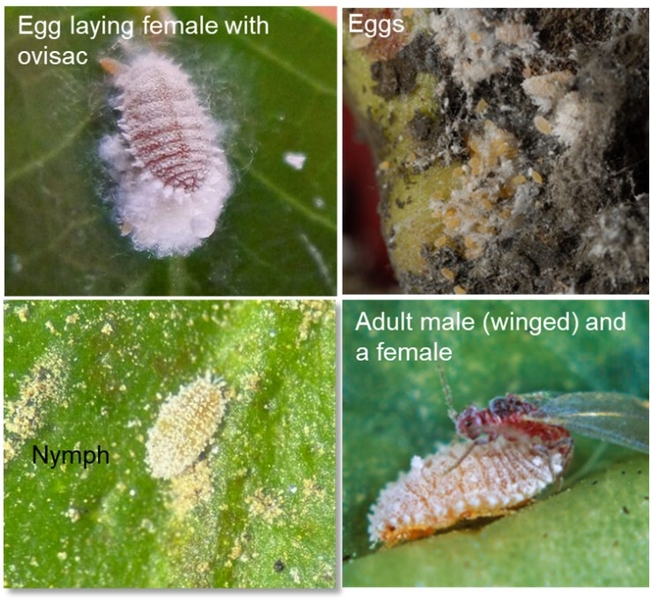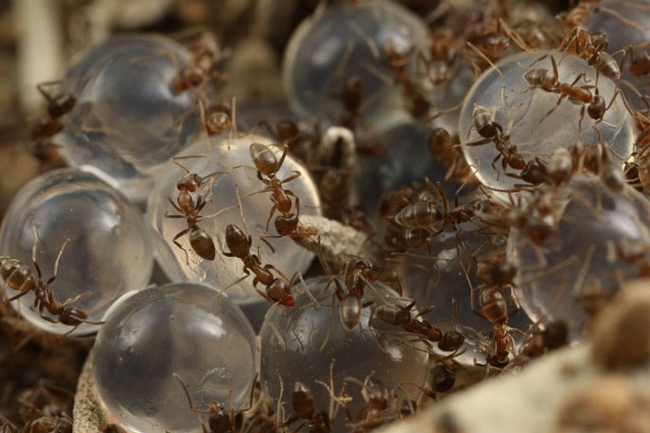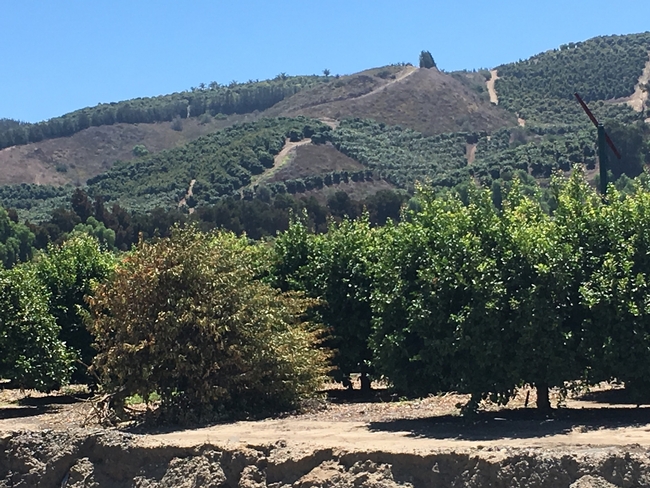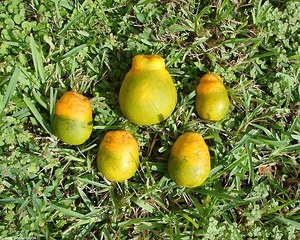UCR wages $11+ million war against citrus greening disease
Three projects win funding to fight tree-killing bacteria
Managing citrus mealybug – does ant control help?
Sandipa Gautam, Sanjeev Dhungana, and David Haviland
UC Co-operative Extension
Starting 2019/20 season, pest control advisors started noticing citrus mealybug infestations in multiple citrus varieties that continued to increase in acreage in the San Joaquin Valley. Although present in the citrus systems, mealybugs were considered to be a minor pest and kept well under check by natural enemies until recently.
What are mealybugs?
Mealybugs are soft, oval, flat, distinctly segmented insects whose body is covered in white mealy wax. Citrus mealybug, Planococcus citri is the most common species associated with citrus. Females lay ~600 eggs in egg sacs loosely held by white cottony flint. Crawlers are yellowish, and can move or be carried by ants, birds, or the wind to start new infestations. Crawlers feed by sucking sap using straw-like stylets and soon develop a waxy covering (Fig. 1C). Like California red scale, females molt and stay as third instars until mated by a male. Males go through a pupal stage and emerge as adults with wings that fly to seek a mate.
Mealybugs prefer the inside canopy of the tree and can be found under dense leaves, between clusters of fruits, or in other cryptic places where they can be difficult to find, especially when the population is low. As the season progresses and the tree flushes, blooms, and fruit develops, mealybugs move to the parts of the tree where nutrients flow. Ongoing research on seasonal phenology suggest that there are 5-6 generations in the San Joaquin Valley. The first generation starts from overwintering adult/egg populations in late March/early April. The second-generation crawlers/nymphs move to fruit in June/July. The remaining generations each year primarily feed and multiply on the fruit.
Mealybugs produce nutrient rich honeydew that is an attractive food source for ants. Ants have been reported to defend insect colonies from predators and parasitoids. In an early infestation, ant trails can be used as an indicator to locate mealybug infestations or other sap sucking pests. Managing sugar feeding ants in citrus orchards has shown increased biocontrol of sap sucking insects. It is plausible that loss of chlorpyrifos as an ant control tool may have aggravated ants thereby aiding to increase mealybug pressure in recent years.
As mealybugs have become a reoccurring pest in citrus orchards, University of California researchers-initiated studies to work towards developing strategies to manage this pest. Research funded by Citrus Research Board and led by Gautam lab is investigating biology, field ecology, and management of mealybugs. During field visits, our observations have shown that various ant species of were present throughout the growing season attending mealybug colonies.
Does managing ant help suppress mealybug?
UC researchers have documented that managing sugar feeding ants increases biocontrol, thereby reducing the pest pressure of sap sucking insects. When ant densities are were reduced >90%, there was ~90% less mealybug on twigs and complete elimination of mealybug was reported from fruit. However, managing ants has been a challenge since the use of chlorpyrifos was banned. To address this need, UC researchers have worked to develop and test different types of hydrogel beads for delivering insecticide products to sugar-feeding species of ants.
Research led by David Haviland has focused on the experimental use of commercially-available polyacrylamide hydrogel beads for large field-scale applications. In 2023 a large-scale field trial was conducted in a 20-acre grapefruit block in Sanger, California. Two applications of hydrogel beads laced with insecticides were made on Aug 2 and August 30, 2023. Post-treatment evaluations for ant density were done on 24 trees/plot by counting the number of ants that passed through a graft union for 15 secs weekly for 4 weeks after each application. The effects of ant suppression on mealybug densities was evaluated in October 2023 by counting the number of fruits infested with mealybugs (presence/absence) on 30 fruits from the inside canopy. Insecticide treatments had variable results on ant density, with lowest ant density consistently found in plots treated with thiamethoxam. Similarly, plots treated with thiamethoxam had the lowest populations of mealybugs.
There's a lot more to this story:
https://ceventura.ucanr.edu/Com_Ag/Subtropical/?newsletteritem=100493

Update on Novel Ant Control Method in Citrus (MyAgLife in Citrus, Episode 828)
Recently, the Citrus Research Boards, IPM Entomologist, Ivan Milosavljevi?, Ph.D., was a guest on Episode 828 of MyAgLife in Citrus, where he provided an update on on a novel method of ant control in citrus. This method utilizes hydrogel beads filled with trace pesticide amounts.
To listen to the episode, please click below.
Episode 828 | April 30, 2024 | MyAgLife in Citrus – MyAgLife Daily News Report

With three new grants totaling more than $11 million, UC Riverside is helping lead the fight against citrus greening or Huanglongbing, a disease threatening citrus industries in the U.S. and worldwide.
The disease is from bacteria transmitted to citrus trees by a tiny flying insect, the Asian citrus psyllid. Infected trees produce no fruit, or fruit that is bitter, small and worthless. Despite intensive research for the past 15 years, there is no known cure for it. It has reduced citrus production in Florida by more than 75%, and it has already been detected in Texas and California.
Because California supplies the country with 80% of its fresh citrus, and because 267,000 acres of Golden State lemons, oranges, grapefruits, and mandarins are at stake if operations are permanently lost, the USDA National Institute of Food and Agriculture is making an emergency investment in citrus disease research with three projects at UCR.
These projects focus on instilling tolerance to the disease with three different approaches: below ground, in the rootstocks, above ground in the shoots and branches, and systemically, with a peptide that would move throughout the tree.
The largest of the projects, at $6.8 million, is being led by Danelle Seymour, assistant professor of genetics in the Botany and Plant Sciences Department at UCR. Their focus is on breeding Huanglongbing or HLB-resistant rootstocks, and the project depends on collaboration with Kim Bowman, a citrus breeder at the USDA Agricultural Research Service in Ft. Pierce, Florida.
“In Florida, nearly every single tree is infected. It's terrible for growers, but wonderful for breeding,” Seymour said. “We can't do this research at large scale in California because the disease isn't as widespread here.”
The classic way to improve resistance or encourage new qualities in crops is through genetics, making crosses between one plant that has a favorable trait, and one that doesn't. “We hope the result is better than the parents,” Seymour said. “When you work in wheat or tomato, you can do these crosses and perform evaluations every year. In citrus, it takes 10 - 15 years to evaluate a new generation of trees.”
Because of the long lag time, the research-ready trees in Florida represent an opportunity for Seymour's team to begin examining new crosses now. The breeder, Kim Bowman, has evaluated over 10,000 trees and unique hybrids, from which a handful will be selected for release to growers.
In addition to evaluating these select few new hybrids for their HLB tolerance, the researchers will be watching the Florida-grown trees' responses to the different environmental conditions in California. “Can they perform well in response to different salinity levels in the soil, different humidity, as well as other pests and pathogens that we have here? We'll find out,” Seymour said.
Chandrika Ramadugu, a project scientist also in UCR's Department of Botany and Plant Sciences, is leading a project to develop HLB-resistant scion varieties that can be grafted to rootstocks. A scion is an above-ground portion of a plant, such as a bud or shoot, that can be used for grafting.
For trees, grafting can be equated to an organ transplant. The scion from one tree is attached to the trunk or rootstock of another with the hope of creating a new plant with combined attributes.
With its grant of $3.28 million, this project will analyze second-generation hybrids that are bred for ten years using Australian lime as a source of disease resistance.
Ramadugu will evaluate 24 novel hybrids in California, Florida, and Texas to assess resistance to HLB. Ideally, in addition to having enhanced disease tolerance, the new plants will also be able to produce good-tasting fruit.
There is little genetic diversity in cultivated citrus. When new pathogens arrive, the genetic uniformity can result in disease epidemics and dire consequences for the crop. In addition to the potential benefits of this project for the fight against HLB, the new hybrids may also help protect citrus from other pests and pathogens.
A third project, granted $1.36 million, will utilize a peptide found in Australian finger limes that is known to impart HLB resistance. Led by Hailing Jin, Microbiology & Plant Pathology professor, the project is developing ways to infuse trees with the peptide.
“The antimicrobial peptide in the finger limes are more efficient at killing bacteria as compared to antibiotics currently used in the field, and much more stable at high temperatures,” Jin said.
Because spray applications are expensive, Jin's project aims to spread the peptide throughout the trees' insides. In collaboration with University of Florida professor Svetlana Folimonova, Jin's team utilizes a natural citrus virus with almost no symptoms to deliver the peptide into the trees.
“You infect the tree with the virus, and it will spread in areas where the bacteria reside,” Jin said. “It would move systemically through the tree, and it would be very cost efficient for growers. No need to buy more insecticides.”
These grants were enabled by the 2018 Agricultural Improvement Act, which authorized the Emergency Citrus Disease Research and Development Trust Fund to fight HLB. With these and other projects, the USDA is bringing together the nation's top scientists to find scientifically sound solutions to the problem in a financially and ecologically sustainable way.

|

So what causes these wounds on leaves and fruit on lemons? Corky, sunken blisters on the leaves. Small divots in the fruit. Some of the spots had halos around them, but most not. That would indicate an infection of some sort. It was showing up in a large orchard near Santa Paula.The growers indicated that maybe 20% of the fruit was affected.
Insects? None. Disease? Not really. More damage was on the fruit than leaves, but what would cause what looked like mechanical damage like this? Outside fruit and mostly on the outside of the outside fruit. Wind poking stems? Frost heave? Hail?
Looking round the area at other orchards, other owners, other management practices, old trees and new. The whole area had the problem and it was only on lemons. It wasn't on opuntia cactus or some nearby avocados, oleanders, or roses. But it was something real and it was something that had happened in that area. Rain. High humidity. Things we don't normally see here in the summer time. And what do we get - Edema. Cell Burst. Mesophyll Collapse.
Edema may be caused by any agent that stimulates an abnormal increase in the size and number of a group of inner cells. Edema can be induced by (1) spraying with some chemicals such as ammoniacal copper carbonate in an oil emulsion, (2) injuries resulting from wind-blown sand particles and sucking insects, (3) high light intensity, and (4) accumulation of water in the intercellular spaces.
The most common cause of edema is the presence of abundant, warm soil water and a cool, moist atmosphere. Under these conditions the roots absorb water at a rate faster than is lost through transpiration. Excess water accumulates in the leaf, some parenchyma cells enlarge and block the stomatal openings through which water vapor is normally released from the plant; thereby contributing to further water retention in the leaf. If this condition persists, the enlarged cells divide, differentiate a cork cambium, and develop elongate cork cells externally to form a periderm. The rupture of the epidermis by the enlarged inner cells and the periderm account for the raised, crusty appearance of older edema spots and also corky veins.
So what can a lemon grower do? Especially since more rain is forecast for this coming year.
1. Avoid irrigation or watering during cool, overcast humid weather. Irrigate when soils need to be watered. Avoid a fix schedule and when humidities are high.
2. Avoid overfertilizing, especially when the plants are growing slowly, such as during the winter months. Maintain fertility based on a leaf analysis. Avoid low levels of potassium and calcium.
Photo:
Early on, the black spots on the fruit start out as a clear exudate. The same for the brown spots on the leaves.